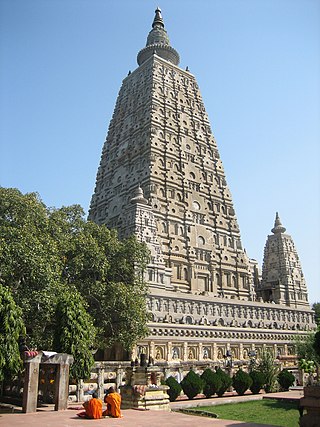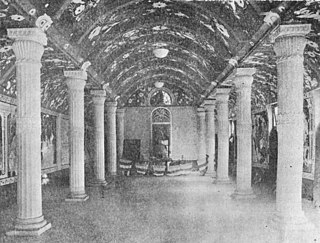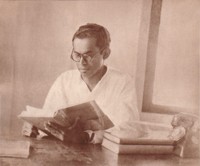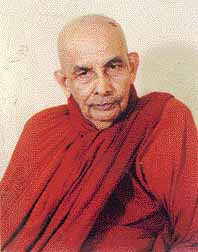
Bodh Gayā is a religious site and place of pilgrimage associated with the Mahabodhi Temple complex, situated in the Gaya district in the Indian state of Bihar. It is famous for being the place where Gautama Buddha is said to have attained enlightenment under what became known as the Bodhi Tree. Since antiquity, Bodh Gaya has remained the object of pilgrimage and veneration, for Hindus and Buddhists both. In particular, archaeological finds, including sculptures, show that the site was in use by Buddhists since the Mauryan period.

The Mahabodhi Temple or the Mahābodhi Mahāvihāra, a UNESCO World Heritage Site, is an ancient, but rebuilt and restored Buddhist temple in Bodh Gaya, Bihar, India, marking the location where the Buddha is said to have attained enlightenment. Bodh Gaya is 15 km from Gaya and is about 96 km (60 mi) from Patna. The site contains a descendant of the Bodhi Tree under which the Buddha gained enlightenment, and has been a major pilgrimage destination of Buddhists for over two thousand years.

The Bodhi Tree, also called the Mahabodhi Tree, Bo Tree, is a large sacred fig tree located in Bodh Gaya, Bihar, India. Siddhartha Gautama, the spiritual teacher who became known as the Buddha, is said to have attained enlightenment or buddhahood circa 500 BCE under this tree. In religious iconography, the Bodhi Tree is recognizable by its heart-shaped leaves, which are usually prominently displayed.

Anagārika Dharmapāla was a Sri Lankan Buddhist revivalist and a writer.

Balangoda Ananda Maitreya Thero was a Sri Lankan Buddhist monk who was one of the most distinguished scholars and expositors of Theravada Buddhism in the twentieth century. He was highly respected by Sri Lankan Buddhists, who believed that he had achieved a higher level of spiritual development. Sri Lankan Buddhists also considered Balangoda Ananda Maitreya Thero as a Bodhisattva, who will attain Buddhahood in a future life.

The Maha Bodhi Society is a South Asian Buddhist society presently based in Kolkata, India. Founded by the Sri Lankan Buddhist leader Anagarika Dharmapala and the British journalist and poet Sir Edwin Arnold, its first office was in Bodh Gaya. The organization's efforts began in order to resuscitate Buddhism in India, and to restore the ancient Buddhist shrines at Bodh Gaya, Sarnath and Kushinara. The restoration and revival of the glory and sanctity of Bodh Gaya are also aims of Maha Bodhi Society.

Bhikkhu Bodhi, born Jeffrey Block, is an American Theravada Buddhist monk ordained in Sri Lanka. He teaches in the New York and New Jersey area. He was appointed the second president of the Buddhist Publication Society and has edited and authored several publications grounded in the Theravada Buddhist tradition.

Nyanaponika Thera or Nyanaponika Mahathera was a German-born Theravada Buddhist monk and scholar who, after ordaining in Sri Lanka, later became the co-founder of the Buddhist Publication Society and author of numerous seminal books and articles on Theravada Buddhism. He mentored and taught a whole generation of Western Buddhist leaders such as Bhikkhu Bodhi.
Atamasthana or Eight sacred places are a series of locations in Sri Lanka where the Buddha had visited during his three visits to the country. The sacred places are known as Jaya Sri Maha Bodhiya, Ruwanwelisaya, Thuparamaya, Lovamahapaya, Abhayagiri Dagaba, Jetavanarama, Mirisaveti Stupa and Lankarama. They are situated in Anuradhapura, the capital of the ancient Anuradhapura Kingdom.

Piyadassi Maha Thera was a preacher of the Dhamma both in Sinhala and in English. He was born on 8 July 1914 at Kotahena in Colombo, Sri Lanka and was educated at Nalanda College, Colombo, thereafter at the University of Sri Lanka and the Center for the Study of World Religions at Harvard University as a research student.
Buddhist Cultural Centre (BCC) in Sri Lanka was founded by Ven. Kirama Wimalajhoti Thera who had returned to Sri Lanka after twenty years of dedicated missionary activity in Malaysia, Singapore and US. It was inaugurated on January 2, 1992 under the auspices of Ven. Dr. K. Sri Dhammananda Thera, the chief prelate of Malaysia and Singapore and a plethora of other internationally famed Buddhist scholar monks of the time. It sought to fill a need of the devoted Buddhists in Sri Lanka and the rest of the world. What made Ven. Wimalajhoti Thera start the BCC was the dearth of Buddhist publications in Sri Lanka notwithstanding its reputation as a country where Buddhism prevails in its pristine form. This fact was pointed to Ven. Wimalajhoti Thera by some of his foreign neophytes who had arrived in Sri Lanka to learn Buddhism when they had strolled quite unsuccessfully all over the outskirts of Colombo along with him in search of some Buddhist publications.

The German Dharmaduta Society is an organization established to promote Buddhism in Germany and other Western Countries, and was founded by Asoka Weeraratna, in Colombo, Sri Lanka on 21 September 1952.

Most Venerable Madihe Pannaseeha Mahathera was an eminent Sri Lankan Buddhist monk, who was the Mahanayaka of Amarapura sect from July 13, 1969, until his death on September 9, 2003.

The London Buddhist Vihara is one of the main Theravada Buddhist temples in the United Kingdom. The Vihara was the first Sri Lankan Buddhist monastery to be established outside Asia.

Rajguru Aggavamsa Mahathera was one of the delegates from Bangladesh) in the Sixth Buddhist council held in Yangon, Burma in 1956.

Bodagama Chandima Thero is a Buddhist monk. As of 2015 he taught Theravada Buddhism in Taiwan. With a group of Taiwanese Buddhists, he founded the Theravada Samadhi Education Association in Taipei.

Hikkaduwe Sri Sumangala Thera was a Sri Lankan Buddhist monk, who was one of the pioneers of Sri Lankan Buddhist revivalist movement in the 19th century. He did a great service to improve the Buddhist Education in the country and was the founder of Vidyodaya Pirivena, Maligakanda in 1873, which was granted the university status later in 1959 by the Government of Sri Lanka. A veteran author and a fiery orator, he was a major figure in the Panadurawadaya, a religious debate held between Christian missionaries and Buddhist monks in 1873 at Panadura, Sri Lanka. He was well versed in Sinhala, Pali, Sanskrit, English, Buddhism, history, arithmetic, and archaeology and was one of the primary sources of information on Buddhism for the success of the Panadura debate.
Mahanayaka theros are high-ranking Buddhist monks who oversee and regulate the Buddhist clergy in Theravada Buddhist countries. The title Maha Nayaka translates to English as 'Great Leader' and it is considered to be a very important position held by a monk in a Theravada Buddhist country. It is usually bestowed upon the senior Buddhist monks who are appointed the chief prelates of monastic fraternities known as Nikayas.

Rerukane Chandawimala Thero was a Sri Lankan Buddhist monk and author. A personality of Sri Lankan Buddhism in the 20th century, he has been regarded as one of the finest scholars of Tripitaka, the sacred canon of Theravada Buddhism. He was also a Buddhist meditation master, professor of Abhidharma and a former Maha Nayaka of the Swegin chapter of the Amarapura Nikaya. Rerukane Chandawimala Thero was a highly reputed author of Theravada Buddhism, especially on Abhidharma. His books are considered as text books by other authors as well as students.

















